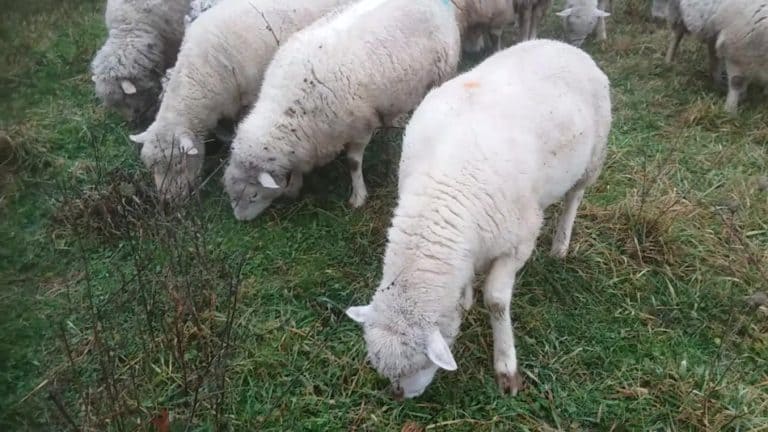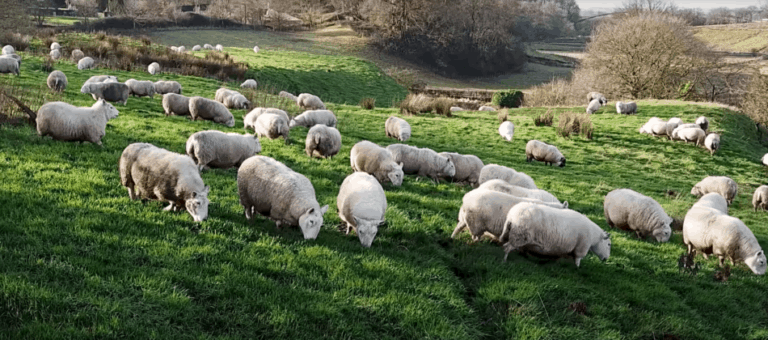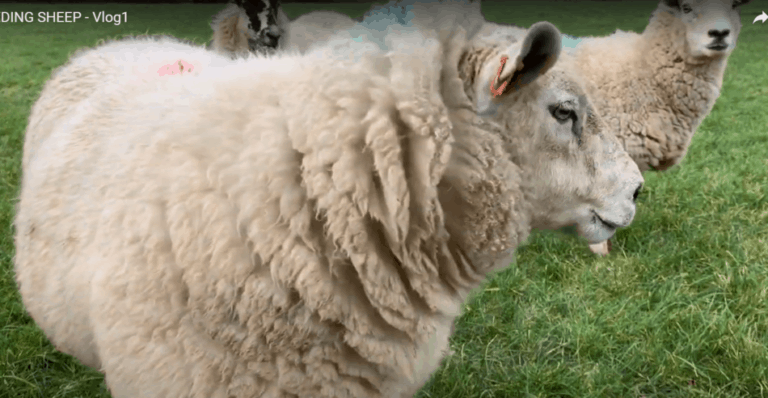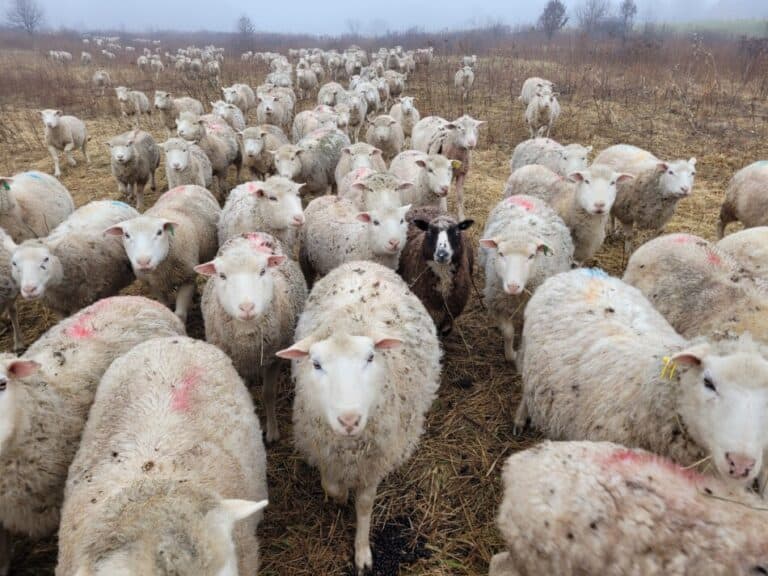How Many Sheep Can You Have Per Acre?

When you are thinking of raising some sheep, you need to know how many to start out with. But…how do you figure out how many sheep you need since every area of the country is so different?
An area with productive land can support 5 sheep per acre, while a less productive area can support 1 sheep per acre and arid land will support a fraction of a sheep per acre. A 1/4 acre lawn can support two feeder lambs. You need to raise a minimum of two sheep, raising three sheep together is better for the sheep.
| Sheep raising situation | Number of sheep |
| Minimum number of sheep per group | 2 sheep (3 is better) |
| Number of sheep to graze a .25 acre lawn for the summer | 2 feeder lambs |
| Amount of sheep comfortably housed in a 12ft. x 20 ft. shed | 12 ewes with lambs |
| Amount of sheep per acre of productive land | 5 ewes with lambs |
| Amount of sheep per acre of less productive land | 1 ewe with lambs |
Sheep are versatile and can live nearly anywhere there is grass to be eaten. How many sheep you can raise depends upon the forage available, the land and the size of the sheep.
Raising Sheep For Profit is an article I wrote for anyone interested in the business side of sheep, budget and expenses included.
Sheep need to live in a group
The easiest answer to how many sheep you need is that you need more than one sheep of the same age.
How many more, we’ll get into later, but for now, know that sheep do not live healthy lives when they are on their own.
Sheep need to live in a group, called a flock. Being in a group makes sheep feel safe and is an instinctual need, meaning they are not choosing to be this way, they just are.
If you have a ewe with a lamb, she still wants to be with other sheep.
She needs a few more adult sheep to feel safe, even though with her lamb she is already in a group. She doesn’t view it that way, to her a group is other adult sheep.
Sheep need a certain amount of space per head
Looking at the chart above, you’ll see a variety of situations that you might be raising sheep in. Let’s go over them in a bit more detail.
Sheep can eat your lawn for the summer
Raising two feeder lambs (lambs that are going to the freezer) for the summer means you will need .25 acres of lawn that grows well for two lambs.
Adult sheep can also graze your yard for you, but will need more land or to have the grass supplemented with hay in order to meet their feeding needs since they will live with you year round.
Sheep can be kept in a small building or shed
Sheep can be kept inside a smaller building that you may already have on your property. In this case we are using a larger shed, as an example.
This larger sized shed is 12 ft. x 20 ft. (the size of a small garage) giving 240 sq. ft. which is enough space for 12 ewes with lambs since the ewes with lambs need 20 sq. ft. each.
I used a garage size shed as an example, but please note that a modern type of garage is not healthy for sheep, since it is so well sealed. Sheep, like all livestock, need air flow.
You are looking for a 3 sided shed or something similar that has plenty of air movement for the sheep.
Productive land can feed more sheep per acre
While sheep can be raised all over the country, the number of sheep you can have per acre varies considerably.
Around here, Ohio, we can have 5 ewes with lambs (or one animal unit) per acre. An animal unit is 1,000 pounds live weight of forage eating animals.
Check out your state agronomy guide for this information on your area.
Less productive land can feed one sheep per acre
As with the productive land, the ability of the less productive land to produce forage varies.
As a general rule, or at least a good place to start your calculations, go with 1 ewe per acre for grazing conditions like Wyoming.
This is based off of needing 5 acres per cow (Cattle Forum) and 5 sheep equaling one cow, as far as grazing goes gets you 1 ewe per acre in these grazing conditions.
When you are looking into information on grazing, don’t be surprised when you come across cattle per acre numbers. This is because cattle are more popular than sheep.
Take the cattle numbers and for every one cow calculate 5 sheep.
Check out your state agronomy guide for the number of sheep you can have per acre in your specific area.
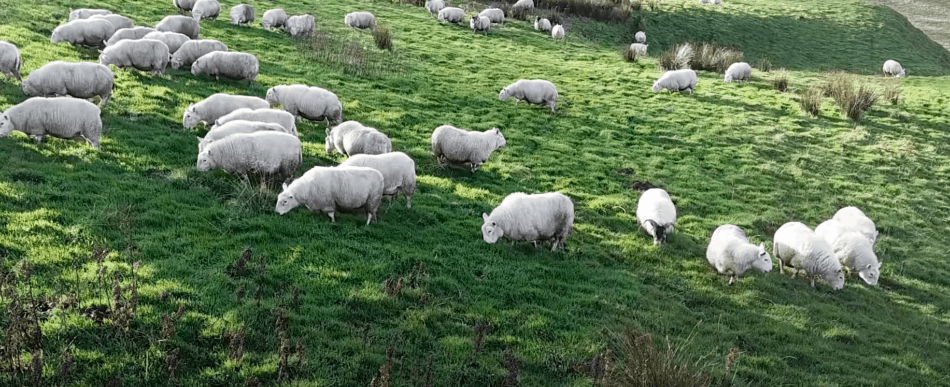
Calculate the amount of land you have available
How much land do you have available for your sheep? This could be multiple acres or part of an acre.
The size does not matter quite yet, what you need to know now is what is the amount of space you are working with.
My article How Much Land Do You Need To Raise Sheep? will cover this in detail.
There are 43,560 square feet in an acre. The rest of this information will be based on acreage, so keep this number in mind.
You are looking for a number like 3 acres, or .6 acres. You just need something to get started working some calculations off of.
I have some examples below, using a .25 acre lawn and a 5 acre pasture. It’s just math, no matter how big or small of an area you are working with, all you need to do is find the numbers to start.
You can rent land for your sheep to graze
If you are considering renting land for your sheep, read Establishing a Fair Pasture Rental Rate, it’s very interesting and gives multiple ways to figure up what would be a fair price to pay for grazing land.
Look again at the Cheviot mules pictured above, these are owned by Cameron Wilson, a shearer and shepherd in Scotland.
He raises over 600 ewes in Scotland and owns no land, it’s all rented! Could you do something similar?
He also has a great YouTube channel The Sheep Game, check it out.
Look at your naturally growing forages
You’ll want to know the naturally growing forages in your area and specifically in your planned sheep pasture.
You are looking for specific species, like Orchard grass or Timothy, two common grasses around here.
Some plants produce quite a bit of forage per acre, others not so much.
When you know what plants you have, you’ll be better able to figure out how much grazing your area is likely to have for the growing season.
Find forage production estimates in your state agronomy guide
Once you know what is growing, you can look in the state agronomy guide and figure up the hay yield per acre of these grasses for your area.
If you are lucky, your state agronomy guide will give you stocking rates for grazing by species. That would be super and exactly what you are looking for.
If you aren’t so lucky, (we aren’t!) you’ll have to do a few hay production based calculations to get a good guess as to the forage growth you can expect from your pasture for the year.
Take a close look at your climate
Now you need to look at the calendar and think about the year, weather wise, in your area.
When do people start mowing their lawns? When do farmers fields start to green up or get the first cutting of hay mowed off?
Look at the opposite end of the year, as well. When do people stop mowing their lawns? When do you not see green forages in the hay fields anymore?
Around here, we hope to be grazing April 1st, definitely by mid April. Some years we aren’t even close, but with an early spring April 1st is doable here.
We usually stop grazing sometime in November. Once again, this depends upon the year.
For reference, our frost free dates for gardening are May 15-October 15 (Ohio, zone 5), so the grazing season is a bit longer than this.
Determine the days you need to feed hay each non growing season
Now that you know what you can expect for the growing season, you need to figure up the remaining months of the year.
For us, the non growing season is December 1st through April 1st, or 4 months. This is the minimum amount of time we will feed hay each winter.
If spring is late or winter sets in early, we’ll end up feeding hay for more than 4 months.
You need to find the months of the year that you will need to provide hay to your stock. In really warm or dry areas, this could be in the heat of the summer, as well.
Figure up your sheep stocking rate for your land
Now we put all of these numbers together. Since I don’t know where you live, I’ll use some examples to show you how to figure up the number of sheep that you can comfortably have on your land.
Usually how many animals that can graze in an area are figured up as animal units.
Using animal units allows you to figure up cattle, sheep or goats per acre and is commonly used in agronomy guides, so you might see this term.
When you come across animal units for your area, great news! Things just got a lot easier. If you don’t find this figure, that’s okay, we’ll keep going and find the appropriate stocking rate for ourselves.
Pick the example that is the closest to your situation and use numbers that are appropriate for your area.
Figuring the number of sheep for your situation, example 1
Example 1:
- 6 month growing season
- 1 animal unit per acre (5 sheep is one animal unit)
- 5 acres of land that is grazable with forage that grows 2.8 tons of hay per acre
In this example total growing season forage production is 14 tons (5 x 2.8) of hay equivalent from the 5 acres of sheep pasture. (Search hay production for your state to get tons per acre for your area.)
Sheep eat 3.5% of their bodyweight in hay or hay equivalent per day. Your sheep weigh 150 pounds each, which is 5.25 pounds of hay per day.
The grazing season is 6 months, which is 180 days, equaling 945 pounds of hay (as grass) per sheep.
Your land produces 14 tons, which is 28,000 pounds of hay or enough for 29.6 sheep during the grazing season.
You could feed 30 head of sheep on your 5 acres, as long as you are willing to buy all of the non grazing season hay.
Figuring amount of sheep per acre with a lawn, example 2
Example 2:
- you have a .25 acre lawn
- you want to raise some feeder lambs to market size for the freezer
The lambs you will be buying are called feeder lambs.
These are lambs that you buy weaned and grow them out for the summer on your grass then have them butchered in the fall. You are not keeping these lambs over the winter.
Since bluegrass, a common lawn grass, yields half the forage of more normal hay type grasses like Orchard grass, we’ll use 50% of our 2.8 tons per acre, which will give 1.4 tons per acre in hay equivalent.
We still need to use 3.5% of bodyweight, but since the lambs are growing, we’ll have to make a guess. I’ll use 80 pounds as an average lamb weight (when you first get them, they’ll be smaller).
80 pound lamb x 3.5% equals 2.8 pounds of hay each, per day. Since there are two lambs we’ll double that to 5.6 pounds.
5.6 pounds of hay equivalent per day for 4 months is 672 pounds of hay needed by your feeder lambs.
Your lawn should make 1.4 tons of hay per acre and you have .25 acres, so you should get .35 tons of hay, as grass, off of your .25 lawn. That is 700 pounds of hay equivalent, eaten as lawn grass.
Looking above, you’ll see you need 672 pounds from your lawn for your lambs. You’ve got it! Your .25 acre lawn will grow enough grass for your feeder lambs during the growing season.
What if you want to raise more lambs than your lawn can support?
What if you wanted to raise 4 feeder lambs? What can you do now?
Obviously, you won’t have all of the grass you need for them, but you can feed them some grass and some hay to meet their energy needs.
As long as you are willing to feed some hay, you can have 4 lambs on a .25 acre lawn. If you don’t want to feed hay, you need to get only 2 lambs.
Another option to get four lambs on your lawn is to raise two sets of two lambs. This will spread out the eating over a longer period of time.
Unless you have a huge growing season, you’ll probably need to plan on feeding some hay in this situation, but it would be another way to work out feeding 4 lambs on .25 acres.
The basic calculation is production of the land divided by forage eaten by the sheep, all in a given period of time. Chances are you’ll need to feed some hay. Most areas do not have year round grazing.
Resources:
Image credit: mob of sheep being put into a shearing shed is from The Sheep Game (YouTube)
Sheep 201: Housing, square footage needed per ewe for keeping sheep inside, chart
Cattle Forum, amount of grazing land needed per cow in Wyoming
Grass hay production, ask2extension.org, amount of grass that bluegrass grows compared to other pasture grasses in order to calculate out a hay equivalent
